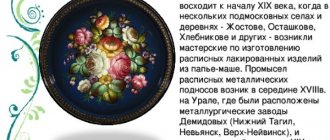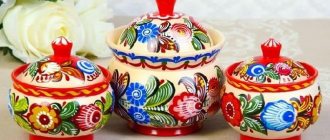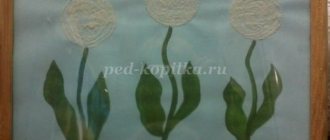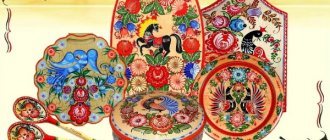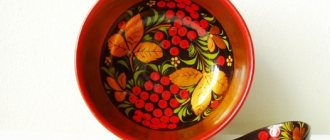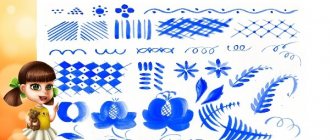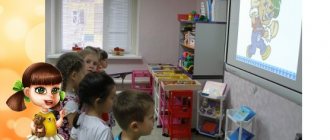Painting a cutting board with Gorodets painting step by step with photos
Painting a cutting board with a Gorodets pattern. Master class with step-by-step photos
Designed for middle and older schoolchildren, teachers, parents, and educators.
Use: as a gift, for interior decoration. Goal: decorative design of a wooden product using traditional elements of Gorodets painting - “horse”, “roses”, “buds” and “cups”. Objectives: - acquaintance with the traditional motif of Gorodets painting - horse, kupavka, bud and rose. - develop creative imagination, fantasy, interest in folk crafts. - be able to pay attention to loved ones.
Materials: cutting board, acrylic paints, flat and round brushes, pencil, glass, sandpaper, palette, clear varnish.
Step-by-step instruction
I would like to bring to your attention the painting of a cutting board with the Gorodets pattern. Women spend most of their time in the kitchen and every housewife creates comfort and warmth with her skill in decorating and ennobling the interior. Your loved ones and friends will be pleased to receive such decoration as a gift, and by turning the board over, you can use it for its intended purpose. I have a rectangular cutting board with a bird in the middle and garlands of flowers and leaves around the edges. The bird in Gorodets painting is a symbol of family happiness, and the flowers are a symbol of health and prosperity. Use sandpaper to sand the surface of the cutting board. Using a pencil, I draw a design on the surface of the board.
Next, we do the underpainting, that is, we paint over the entire composition with a brush, choosing colors at our discretion.
Then, with a smaller brush (2,3) we make a shadow on the composition with a contrasting color. And lightly draw the leaves.
The next stage of our work will be to “revive” the bird. With brush No. 1, add white paint and draw contours and patterns on the bird.
Now we “revive” the garlands of flowers with brush No. 1 with white paint.
And we proceed to the last stage, revitalizing the leaves with brush No. 1 in white and black.
At the end, we outline the edges of the finished board with red acrylic paint for greater expressiveness.
Thank you for your attention!
Good luck in mastering drawing with “Gorodets painting”. Source : https://ped-kopilka.ru/blogs/raisa-vladimirovna-kolomyceva/gorodeckaja-rospis-razdelochnoi-doski-s-poshagovym-foto-6711.html
We recommend watching:
Painting a box with acrylic paints Painting a cutting board using the traditional “Gorodets” technique. Master class with photos Casting and painting gypsum mini-bas-reliefs with a plant composition for beginners. Step by step painting of wooden spoons for beginners step by step with photos
Similar articles:
Painting a cutting board step by step
Coloring pages “Gorodets painting” for children 5-6 years old
What you need to buy for lessons
A modern approach today allows us to apply technologies for using Gorodets painting not only on wood, as it was originally, but also on an ordinary sheet of paper. In the school curriculum, children are introduced to the methods of depicting animals and patterns of Gorodets masters.
To conduct lessons for children, you need to purchase the necessary supplies.
- The material on which the design will be depicted. For children who are just starting to take their first steps in Gorodets painting, the ideal option would be plain paper or cardboard (not glossy).
For those who have already acquired skills in imaging techniques, you can use wooden blanks for work. These can be cutting boards, plates, etc.
- Dye. Her choice also largely depends on how much children practice this skill. If you are a beginner, then gouache paints are suitable. Most common sets of 12 can be used.
- Tassels. They need to be selected in different sizes. It is better if they are brushes made of natural bristles.
- Varnish. If you draw on a wooden surface, then after drying the drawing must be secured with transparent varnish. It will protect the drawing from damage and prevent the colors from fading.
Fine art lesson plan "Gorodets painting" with presentation, 5th grade
Abstract of an art lesson with a presentation on the topic “Gorodets painting”
Author: Natalya Viktorovna Enova, art teacher of MAOU Omutinskaya Secondary School No. 2 Description: abstract of a lesson in fine arts will be useful for fine arts teachers, designed for children 11 – 12 years old (5th grade). Corresponds to the 5th grade fine arts course curriculum. Textbook edited by B.M. Nemensky, Moscow “Enlightenment” 2020. Lesson topic: Gorodets painting. Type of lesson: combined Purpose of the lesson: to create favorable conditions for the formation of theoretical knowledge about Gorodets painting and the formation of practical skills to perform the main elements of Gorodets painting. Objectives of the lesson: Educational: the formation of theoretical knowledge about the emergence of Gorodets painting, its features, as well as the creation of favorable conditions for the formation of practical skills in performing the basic elements of painting: dots, circles, arcs, drops, spirals, strokes. Educational: continue to develop the skills to perceive and analyze material, answer and ask questions; imagination and perception, as well as attention. Continue to cultivate a culture of workplace organization, accuracy, responsibility, independence, perseverance, love for nature and human work. Developmental: continue to develop the ability to work with art supplies, imagination and creativity, and interest in the profession. Planned results: Personal UUD: - readiness and ability for self-development and self-determination; — formation of motivation for learning; — the ability to set goals and make life plans; Meta-subject UUD: Regulatory UUD:
- goal setting - as setting an educational task based on the correlation of what is already known and learned by the student, and what is still unknown;
— planning — determining the sequence of intermediate goals, taking into account the final result; — drawing up a plan and sequence of actions; — forecasting — anticipation of the result and level of assimilation; — control in the form of comparison of the method of action and its result with a given standard in order to detect deviations from it; - correction - making the necessary additions and adjustments to the plan and method of action in the event of a discrepancy between the expected result of the action and its actual product; - assessment - the student’s identification and awareness of what has already been learned and what still needs to be learned, assessing the quality and level of assimilation; Cognitive UUD: General educational UUD:
- independent identification and formulation of a cognitive goal;
— structuring knowledge; — reflection on the methods and conditions of action, control and evaluation of the process and results of activity; - formulation and formulation of the problem, independent creation of activity algorithms when solving problems of a creative and exploratory nature. Logical UUD:
- analysis;
— comparison, classification of objects according to selected characteristics; — establishing cause-and-effect relationships; Statement and solution of the problem:
- formulation of the problem;
Communicative UUD: - planning educational cooperation with the teacher and peers - defining goals, functions of participants, methods of interaction; — asking questions — proactive cooperation in searching and collecting information; - management of the partner’s behavior - control, correction, evaluation of the partner’s actions; - the ability to express one’s thoughts with sufficient completeness and accuracy in accordance with the tasks and conditions of communication, mastery of monologue and dialogic forms of speech in accordance with the grammatical and syntactic norms of the native language. Teaching aids: 1. Material and technical equipment: gouache paints, round synthetic brush No. 6, squirrel brush No. 3, cloth (cotton pads), sippy cup, palette, album. 2. Didactic equipment: presentation: “Gorodets painting” 8 slides. 3. Methodological equipment: outline. Methods of organizing the lesson: - verbal
- conversation, text analysis, explanation, story.
— visual
– demonstration of the presentation “Gorodets painting” 8 slides.
– practical
– doing exercises.
Methods of organizing a lesson: dialogue, oral presentation, conversation, story, explanation of new material, presentation demonstration. Structure of the lesson: 1. Organizational moment (1-2 min.) 2. Reporting the topic and purpose of the lesson (1-2 min.) 2. Updating knowledge and motivating students (7-10 min.) 3. Practical work (27-34 min.) 3.1.
Introductory briefing (1-2 min.) 3.2. Ongoing instruction and independent work (24-29 min.) 3.3. Final briefing (2-3 min.) 4. Summing up (1-2 min.) TOTAL 45 min. Progress of the lesson
1. Organizational moment (1-2 min.)
The teacher welcomes and checks those present, checks the availability of the necessary tools.
2. Statement of the topic and purpose of the lesson (1-2 min.)
Slide demonstration 1. Teacher: today’s topic of our lesson is “Gorodets painting”.
During the lesson, we will get acquainted with the history of Gorodets painting, and also learn how to perform the basic elements of Gorodets painting: dots, brackets, circles, arcs, drops, spirals, strokes. Having learned how to perform them, you can easily draw compositions of Gorodets painting. 3. Updating and motivating knowledge (7-10 min.)
Teacher: on the banks of the Volga there is a glorious and ancient city, but we will now find out what this city is called. To do this, you need to carefully listen to the history of its origin. Slide demonstration 2. Teacher: according to legend, this city was founded in 1152 by Prince Yuri Dolgoruky. The city was founded as a guard fortress. In those days they called it Small Kitezh. During the invasion of Khan Batu, enemies burned and plundered it. But he, like a Phoenix bird, rebuilt himself. What kind of city is this, who guessed?) Student: this is the city of Gorodets. Teacher: That’s right, Gorodets stood in a lively place, next to the famous Makaryevskaya fair. Demonstration of slide 3. Teacher: barges and ships with cargo walked along the Volga, and horse-drawn carts along the roads. Rows stretched for kilometers, in which trade was conducted in different languages; thousands of shops and shops were overflowing with goods brought not only from all over Russia, but also from other countries. Demonstration of slide 4. Teacher: along the banks of the Volga there was a row of wood chips, where they sold sleighs, tubs, troughs, rockers, and bast shoes made of wood. Residents of Gorodets and surrounding villages, such as Kurtsevo, Koskovo, Akhlebaikha, were famous as skilled carpenters and woodcarvers. Forests provided cheap and varied material from which everything was made: from children's toys and cradles to ships. Demonstration of slide 5. Teacher: Gorodets spinning wheels were especially famous. They were bought with pleasure, largely due to the funny painted pictures on the bottom of the spinning wheel. After finishing the work, the hostess hung such a bottom on the wall instead of a painting. Over time, craftsmen began to paint popular print boxes, toys, dishes, furniture and even parts of the house - shutters, doors, gates. Demonstration of slide 6. Teacher: let’s look at what the Gorodets masters painted on their products and what stages of painting the product went through. Demonstration of slide 7. Teacher: thanks to the famous master Lazar Melnikov, in the 19th century, flower buds, roses, and waterfalls appeared in painting. (The teacher shows color samples on the slide). Teacher: For many decades, masters have been practicing techniques for drawing flowers and have developed certain rules. First, a colored background is prepared (often yellow, since wood was previously painted with onion skins), and the main figures are applied to it in the form of large spots of color. This stage is called "underpainting". (The teacher shows on the slide the first stage of painting - underpainting). Teacher: the next stage is called “shadow”, why do you think this stage is called that? Student: Dark colors are used at this stage. Teacher: That’s right, darker burgundy or blue paints are used here. They indicate the center of the flower and the petals. (The teacher shows on the slide the first stage of painting - shadow). Teacher: the final stage of painting is called “revitalization.” Why do you think this stage is called that? Student: Colors are added to help the flower come to life and become more realistic. Teacher: that’s right, it is after this stage that the whole drawing seems to come to life. “Ozhivka” is done with white or black paint. (The teacher shows on the slide the first stage of painting - revival).
4. Practical work (27-34 min.)
4.1 Introductory briefing (1-2 minutes). Teacher: and now we will learn how to depict the main elements of Gorodets painting the way folk craftsmen do. To get closer to the secrets of painting, to become a master, you need to study. What are the master's students called? Student: journeyman. Teacher: task: complete the basic elements of Gorodets painting: dots, brackets, circles, arcs, drops, spirals, strokes on an album of A4 sheet with gouache or acrylic paints with a squirrel brush. For this we will need: an album, a squirrel brush No. 3, a synthetic brush No. 6, a simple pencil, gouache, a palette, a sippy cup. The teacher checks the availability of the necessary materials and shows an example of completing the task “Basic elements of Gorodets painting.”
Teacher: first, let's divide our landscape sheet into 8 lines, and divide the sheet in half (so that our elements are done neatly and there is enough space for all the elements).
The teacher communicates the criteria for assessing the practical task. Criteria for assessing a practical lesson. A grade of “5” (excellent) is given if the work meets all the requirements for completing the task: all the main elements of Gorodets painting are done neatly, there are no marks on the sheet, all completed elements correspond to the teacher’s description. A rating of “4” (good) is given if all the main elements of Gorodets painting are completed and correspond to the teacher’s description; it is allowed to fail to complete 1-2 elements, and there are blots (not done carefully). A grade of “3” (satisfactory) is given if some elements of Gorodets painting are not completed (exercises 1-2), but the remaining exercises are completed and correspond to the teacher’s description. A rating of 2 (not satisfactory) is given if the main elements of Gorodets painting are not completed or there are gross errors in their implementation (do not correspond to the description). 4.2.Independent work and ongoing instruction (24-29 min.) The work is organized as follows. The teacher says what exercise needs to be done, shows the principle of its implementation, and the teachers perform it. The teacher, while the students are performing the element, talks about it in more detail. After several students have completed the exercise, the teacher approaches each one and checks for the completed exercise. Only after the teacher has checked with everyone, the teachers begin the next exercise. Teacher: perform exercises 1-3 in dark green. The first element is a straight drop. The droplet is universal: it can be a small secondary element of registration, decoration, decoration, or it can be independent - Gorodets fan leaves. The droplet size depends on the pressure applied. Teacher: performing the painting element - triple straight drop (right). To the straight double droplet to the right of it we add the same two elements, but of an even smaller size. Teacher: Performing an element of painting - a triple straight drop (on the left). The element is identical to the previous one, but small droplets are located on the left. The teacher approaches each student and checks for the completed exercise 1. Teacher: let’s do exercise 2. Performing the element of painting - a droplet with a turn to the right. It is performed like a straight drop, but when pressing on the hand, we turn the hand a little to the right. From such droplets various border ornaments are obtained. Teacher: performing an element of painting - a droplet with a turn to the left. It is performed similarly to the previous one, but the turn is performed to the left. The teacher approaches each student and checks for the completed exercise 2. Teacher: let’s do exercise 3. Performing the element of painting - a bracket. It resembles the “droplet” element, but at the end of the element the brush also touches the sheet and is drawn thinly. Teacher: performing an element of painting - a triple bracket. To the leaf element to the right of it we add the same two elements, but of an even smaller size. The teacher approaches each student and checks the presence of completed exercise 3. Teacher: we perform exercises 4-5 in red. Let’s do exercise 4 - an arc (of two types). The edges of the petals of the cups and many other details of the painting will not be complete without this element in the painting, lovingly called by the masters “sickle” or “bracket”. The arc can be simple, steep or flat. The execution of the painting element is a simple arc. We begin to point the brush downwards, pressing lightly. When the strongest pressure is applied to the lowest position, the brush itself will seem to want to rise when turning upward. Complete the hair movement by smoothly lifting the brush from the surface. There is also such an element as a steep arc, which is performed in the same way as a simple arc, but the height of the steep arc is higher. Teacher: performing the painting element - a flat arc. It is performed in the same way as a simple arc, but the height of the arc is shallower and lower. The teacher approaches each student and checks that exercise 4 has been completed Teacher: Let’s do exercise 5 - spiral. First, let's put a point, then from the point we begin to draw a circle, thus twisting our arc into a circle. The teacher approaches each student and checks for completed exercise 5. Teacher: let’s do exercise 6 - period. The scattering of dots converging on “no”, made with the wooden end of the brush, looks especially impressive. Brushes of different numbers produce smaller or larger dots. When performing this exercise, do not forget that the paint should not be thick. Teacher: let's do the exercise dots of different sizes. We put a large point and from it four more smaller points. Teacher: let's do the dots in a circle exercise. We put a dot in the middle, and around it small dots (it looks like a flower). The teacher approaches each student and checks for the completed exercise 6. Teacher: let’s do exercise 7 - stroke. A stroke is not even an element. It creates a “shadow”, emphasizes some detail, and is a decoration for berries, Gorodets bouquets, and centerpieces. The “leaf” technique with the “stroke” and “droplet” techniques give all kinds of leaf options. Let's do the stroke exercise, with a slight movement we make straight lines at an angle. Teacher: let's do the double stroke exercise, it is performed identically to the previous element, but a stroke is added at a different angle. The teacher approaches each student and checks that exercise 7 has been completed. 4.3. Final briefing (2-3 min.). The work is organized as follows: students lay out the completed exercises on A4 sheet of paper on the table.
The teacher asks students to find errors in their exercises and the completed exercises of other students. Students discuss their work. 5. Summing up (2-3 min.)
Teacher: the exercises completed today are very important in order to perform Gorodets painting efficiently and correctly, like any other painting, first you need to draw the main elements of this painting, i.e. Gorodets and then you will not have any problems when performing plant motifs, zoomorphic motifs and others, and when we move on to painting finished products of decorative and applied art, the skills you have acquired today will be useful to you. If you have not mastered any element of Gorodets painting well, for example, you were unable to complete the drop with a turn exercise, then at home you need to continue performing this element in order to gain the necessary skill. The teacher dictates homework: 1. Bring all the necessary art materials: album, gouache, synthetic brush No. 6, squirrel No. 3. Show slide 8. Teacher: thank you for the lesson.
Have a nice day, everyone. Goodbye. Presentation on the topic: History of Gorodets painting
We recommend watching:
Gorodets painting on a cutting board Gorodets painting on a cutting board. Master class with step-by-step photos Gorodets painting of a cutting board. Master class with step-by-step photos Do-it-yourself panels made of colored paper. Master class with photos “Gorodets patterns”
Similar articles:
Gorodets painting. Master Class
Lesson on the topic: “Gorodets painting”
Lesson summary on the topic “Gorodets painting”
(5th grade of the Municipal Educational Institution Secondary School of Sengiley named after Hero of the Soviet Union N.N. Verbin)
Goal: to introduce children to the types of Gorodets painting. Teach students to draw up a sketch of a painting on their own. To develop the ability to work with paints and cultivate artistic taste.
Materials: watercolor, brushes, palette, templates, scissors, eraser, pencil, water jar, napkins.
Visual range: samples of Gorodets painting, sketches of the placement of compositions, reproductions of products painted by artists, drawings (on sheets of paper on a board); computer, multimedia projector.
Musical range : Russian folk music (background).
Lesson Plan
I. _ Organizing time
. Greeting, checking students' preparedness for the lesson, organizing attention.
II . Updating the subjective experience of students.
Teacher. Children! In previous lessons, we studied different types of painting of toys, clay and earthenware products, at home you looked at painted household items and remembered all the elements on them, which we may need today for drawing. What painted household items do you have in your home? What patterns did you see on them?
Each of you has things and objects at home that have pictures on them. These are flowers, birds, trees, animals and even corners of nature.
Today you will complete a sketch of Gorodets painting, choosing a specific type ( floral painting, floral painting with horse or bird motifs, plot painting ).
You must complete this painting, as the Gorodets artists do (short conversation, discussion of substantive solutions). And most importantly, we will learn to draw beautiful and fabulous flowers (rosan, kupavka, bud), which, according to legend, bloom on the night of Ivan Kupala.
And now I’ll tell you about Gorodets painting (conversation). During the conversation, slides, reproductions and paintings by artists depicting the painting are shown.
70 km. from Nizhny Novgorod on the left bank of the Volga is located the most ancient city of the Nizhny Novgorod region - Gorodets. It was founded in 1152 by Prince Yuri Dolgoruky in order to strengthen the eastern borders of the Rostov-Suzdal principality. In those days Gorodets was called Small Kitezh. During the invasion of Khan Batu, enemies burned and plundered Gorodets. But he, like a Phoenix bird, rebuilt himself.
Gorodets stood in a lively place, next to the famous Makaryevskaya Fair. Barges and ships with cargo walked along the Volga, and horse-drawn carts walked along the roads. Rows stretched for kilometers, in which trade was conducted in different languages, thousands of shops and shops were overflowing with goods brought not only from all over Russia, but also from other countries. They brought everything they knew how to do. Along the banks of the Volga there was a row of wood chips, where they sold sleighs, tubs, troughs, rockers, and bast shoes made of wood.
Residents of Gorodets and surrounding villages (Kurtsevo, Koskovo, Akhlebaikha) were famous as skilled carpenters and woodcarvers. Forests provided cheap and varied material from which everything was made: from children's toys and cradles to ships. Gorodets spinning wheels were especially famous. They were bought with pleasure, largely due to the funny painted pictures on the bottom of the spinning wheel. After finishing work, the hostess hung this on the wall instead of a painting.
Gorodets painting originates from carved Gorodets spinning wheels. To decorate Donetsk, Gorodets craftsmen used a unique technique - inlay: figures were cut out of different types of wood and inserted into a correspondingly shaped recess. Later, craftsmen began to use tinting for visual richness, a bright combination of yellow with dark oak, the addition of blue, green, and red colors made the bottom even more elegant and colorful. A famous master of inlaid !donets with tinting was the artist Melnikov.
Gorodets painting - how could we not know it?
There are hot horses here, well done.
There are such bouquets here that it is impossible to describe.
There are such stories here that nothing in a fairy tale can be said
III . Learning new knowledge and ways of doing things.
Teacher. Children, look at the board, you see, sketches of cutting boards are made on sheets of paper. What do they show? What do you think is missing here? Yes, right. These paintings lack flowers and small elements : roses, baths;
buds and leaves.
(Examples of placement of pictures on the topic). How did master artists work on them? !
At first, the artists drew up sketches of the painting, then placed images of animals, birds, people and other elements so that they were interconnected. And then they drew small details.
IV . The stage of initial testing of understanding of what has been learned.
- On the board hang samples of drawings of cutting boards with Gorodets painting. Let's try together to create different options for compositions: floral ,
floral with horse or bird motifs
(work with students on the board, (front), arousing students' interest in drawing).
Teacher. Everyone, look at how I will draw the composition I have chosen (showing the drawing sequence on the diagrams,! on the board and sample drawing) Explains how to work with paints correctly.
Installation for project implementation. Selecting a task in groups, individual and collective work, taking into account the educational goal and task. Carry out self-control, participate in the discussion of the content of the task. Students work independently. They select drawings, think through their composition, exchange opinions and assessments of their actions.
Well done. You are up to the task. You get a beautiful composition. Let's see who will make the most interesting drawing. At the end of the lesson we will hold an exhibition of your work.
V. Control and self-control.
- Students work on composition, drawing (music sounds).
- The teacher reminds you of the sequence of drawing flowers and small elements, how to make a drawing in color and draw it using revival.
Sets the task: to obtain in the drawings a resemblance to the subjects of Gorodets painting. Learn to work with paints carefully.
The teacher once again reminds about the correct placement of the details of the drawing, the correct transfer of proportions, walks through the rows, looks at the students’ work, pays attention to the selection of paints and techniques for working with paints.
Students work in two groups. They complete the assigned tasks, communicate and help each other.
VI . Correction.
Correcting errors in student work.
VII. Homework
. Consider objects with different types of painting.
V II I.
Lesson summary.
Demonstration of student work. Group discussion.
IX . Reflection.
Express your mood.
Teacher of fine arts and drawing Grigoriev A.I.
Master class on drawing for children from 7 years old. Gorodets painting
How to draw a Gorodets pattern on a plate step by step for children from 7 years old
Author: Oksana Nikolaevna Bogatova, teacher of MKDOU “Kindergarten No. 94” Dzerzhinsk, Nizhny Novgorod region. Description: the master class will be of interest to educators, primary school teachers, additional education teachers, and parents. Children 6-7 years old will be able to complete the work with the help of adults, and older children - independently. Purpose: the panel plate can serve as a gift to relatives, friends and also decorate the interior of the kitchen. Goal: creating a decorative panel with Gorodets painting. Objectives: - continue to introduce children to folk crafts; — learn to make a pattern from elements of Gorodets painting; — improve your drawing skills with a thin brush; - develop a sense of composition; - cultivate interest and respect for folk art. Before starting the master class, I suggest taking a moment to remember the history of Gorodets painting and feel its sunny, kind atmosphere.
Gorodets wood painting is a famous folk craft of the Nizhny Novgorod region. It developed in the second half of the 19th century in the Trans-Volga villages near the city of Gorodets. Residents of the surrounding villages were known as skilled artisans, among whom were blacksmiths, weavers, dyers, carvers, carpenters and joiners. There was a lot of forest in the Volga region, and it provided a lot of cheap material from which everything was made: from children's toys to furniture.
Gorodets spinning wheels were especially famous, which were sold in large quantities at the Nizhny Novgorod fair and distributed throughout Russia. People bought them with pleasure thanks to the funny painted pictures on the bottom of the spinning wheel. After finishing work, housewives decorated the walls with such donuts instead of paintings. Soon, such painting began to decorate not only spinning wheels, but also many household items: chairs, baskets, boxes, salt shakers and toys. Gorodets painting is unique in its style, so it is quite difficult to confuse it. Not a single Gorodets product is complete without lush garlands and bouquets of flowers reminiscent of roses and daisies.
The subjects of Gorodets products had a kind of unique plot. Masters depicted gentlemen walking with ladies, riders on horses, tea drinking scenes in rich interiors.
Previously, Gorodets painting was done with egg paints, which were applied to the product in large spots of color, without a preliminary outline. The drawing was applied in free strokes with a graphic outline in black or white. The predominant colors were blue, red, white and black. Nowadays, craftsmen use oil paint, which has expanded the color range. But the motives and technology of Gorodets painting remained the same. Modern artists, as before, paint all kinds of wooden products: boxes, caskets, decorative panels, cabinets, shelves, bread bins, salt shakers, toys and furniture.
It has become a tradition for Nizhny Novgorod schoolchildren to visit Gorodets on excursions.
There they will learn a lot of interesting things from the history of the Nizhny Novgorod region. They plunge into the atmosphere of the life of their ancestors. They can touch everything with their own hands.
And, of course, they participate in master classes by local artists. Children are delighted with such trips.
Now let me introduce my master class on drawing Gorodets painting. Materials: paper plate, white acrylic primer, primer brush, painting brushes No. 1, No. 2, No. 5, gouache (yellow, ruby, white), watercolor paints, simple pencil.
Cover the plate with primer (acrylic dries quickly).
Let's depict one of the elements in the center of the plate - a chamomile. In Gorodets painting, a chamomile can be blue, purple, red, or orange (a multi-petaled fantastic flower). We apply the drawing with a simple pencil.
Stage “underpainting”. We make the background with yellow gouache (brush No. 5).
Mix ruby and white gouache to get a pink color. Making a pink background.
We outline the flower with red watercolor and paint the circle in the center (brush No. 2).
Inside the red petals we make a second row, then with white watercolor we outline the petals around class=”aligncenter” width=”627″ height=”470″[/img] We outline with white the large petals inside and the small ones outside (brush No. 2), add three strokes (white and red) apply dots (brush No. 1).
Now, draw the leaves with mustard color. The leaves in Gorodets painting vary in size, but are always arranged in groups. At the same time, they never exceed the size of the central flower of the composition.
Draw green leaves.
We make veins on the leaves (brush No. 1) - we draw a line along the leaf and several short ones across it.
Veins on green leaves are done differently.
The “revival” stage. We emphasize mustard-colored leaves on all sides with a thin line (brush No. 1) with black paint, and green leaves on one side with tendrils.
Our plate is ready.
In the center of the plate you can depict other options for Gorodets flowers, for example, roses.
An addition is a loop for hanging the panel on the wall.
My work for the holiday of Easter.
Thank you for your attention!
We recommend watching:
Gorodets painting on a cutting board Gorodets painting on a cutting board. Master class with step-by-step photos Gorodets painting of a cutting board. Master class with step-by-step photos Do-it-yourself panels made of colored paper. Master class with photos “Gorodets patterns”
Similar articles:
Gorodets painting. Master Class
